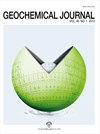H-O、S、He-Ar同位素对海南岛宝伦金矿床成因的约束
IF 1.6
4区 地球科学
Q3 GEOCHEMISTRY & GEOPHYSICS
引用次数: 0
摘要
晚三叠世宝伦金矿床为志留系千层岩赋存物,是海南岛的一个大型金矿床。为探讨成矿物质来源和矿床类型,对含金石英脉流体包裹体的氢氧同位素分析、黄铁矿的氦氩同位素和硫同位素进行了分析。成矿流体氧、氢同位素组成(d 18o = 4.1 ~ 6.5‰,d d = -77.7 ~ -60.5‰)与变质流体不相容,符合岩浆流体特征。黄铁矿的He-Ar同位素组成表明黄铁矿的成矿物质来源于地壳成分和地幔成分。矿化石英脉中黄铁矿和磁黄铁矿的d 34 S值分别为2.3‰~ 6.3‰和1.5‰~ 7.1‰,低于海南岛含矿岩和其他金矿床中黄铁矿的d 34 S值。这些数值均高于地幔,与附近的岩浆岩相似,表明硫主要来源于海南岛的岩浆岩。因此,成矿流体主要是岩浆分异作用的产物,但也不能排除大气降水的作用。基于与剑锋岭花岗岩体密切的时空关系。宝伦金矿床为含地幔成分的碱性花岗岩,并不是造山带型金矿床,而是与侵入体有关的金矿床。综合构造、含矿岩及同位素特征,确定宝伦金矿为沉积型侵入体型金矿床。结合当代葛镇型金矿床(ca。结论表明,海南岛在中晚三叠世曾发生过一次相同的金矿成矿事件。本文章由计算机程序翻译,如有差异,请以英文原文为准。
H-O, S, He-Ar isotopes constrain on the genesis of the Baolun Gold Deposit in Hainan Island, South China
The late Triassic Baolun gold deposit hosted by Silurian phyllites is a large-scale gold deposit in Hainan Island, South China. In order to discuss the source of ore-forming material and deposit type, H-O isotope analyses of fluid inclusion, He-Ar isotopic and S isotopic studies of pyrite have been analyzed from auriferous quartz veins. The oxygen and hydrogen isotopic compositions ( d 18 O = 4.1–6.5‰, d D = –77.7 to –60.5‰) of ore-forming fluid, which are incompatible with metamorphic fluid, coincide with the characteristics of magmatic fluid. The He-Ar isotopic compositions from pyrite imply that the metallogenic material is derived from a crustal component and a mantle component. The d 34 S values of pyrite and pyrrhotite from mineralized quartz veins range from 2.3‰ to 6.3‰ and 1.5‰ to 7.1‰ respectively, which are lower than d 34 S values of pyrite from ore-hosting rocks and other gold deposits in Hainan Island. The values are higher than that derived from the mantle and are similar to magmatic rocks in nearby, which suggest that the sulfur is mainly derived from magmatic rocks of Hainan Island. Hence, the ore-forming fluid is primarily the product of magmatic differentiation, but the contribution of meteoric water could not be excluded. Based on the close spatial and temporal relationship with the Jianfnegling granite pluton ( ca . 240 Ma), which are alkali granites containing mantle components, the Baolun gold deposit is proposed to be an intrusion-related gold deposit instead of presupposed orogenic gold deposit. Based on structures, ore-hosting rocks, and isotope characteristics, the Baolun gold deposit was identified as a sediment-hosted intrusion-related gold deposit. Combined with contemporary Gezhen-type gold deposits ( ca . 228 Ma) that are a series of similar gold deposits hosted by the Baoban Group along the Gezhen ductile shear zone in Hainan Island, it is concluded that an identical gold metallogenic event occurred in Hainan Island during middle-late Triassic.
求助全文
通过发布文献求助,成功后即可免费获取论文全文。
去求助
来源期刊

Geochemical Journal
地学-地球化学与地球物理
CiteScore
1.70
自引率
12.50%
发文量
11
审稿时长
6 months
期刊介绍:
Geochemical Journal is an international journal devoted to original research papers in geochemistry and cosmochemistry. It is the primary journal of the Geochemical Society of Japan. Areas of research are as follows:
Cosmochemistry; Mineral and Rock Chemistry; Volcanology and Hydrothermal Chemistry; Isotope Geochemistry and Geochronology; Atmospheric Chemistry; Hydro- and Marine Chemistry; Organic Geochemistry; Environmental Chemistry.
 求助内容:
求助内容: 应助结果提醒方式:
应助结果提醒方式:


